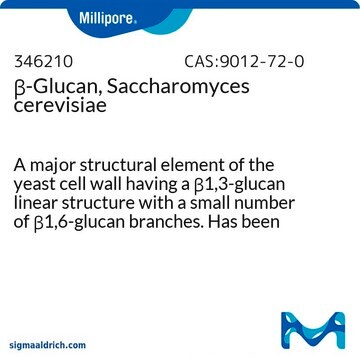67138
β-(1→3)-D-Glucanase from Helix pomatia
≥0.2 U/mg
Sign Into View Organizational & Contract Pricing
All Photos(1)
About This Item
Recommended Products
biological source
Helix pomatia
Quality Level
form
powder
specific activity
≥0.2 U/mg
storage temp.
−20°C
Looking for similar products? Visit Product Comparison Guide
Application
β-(1→3)-D-Glucanase from is used to digest β -1,3-glucan, which is a major component of cell walls. β-(1→3)-D-Glucanase from Helix pomatia has been used fto digest the cell walls of C. albicans .
Biochem/physiol Actions
Deletion of the C.albicans histidine kinase gene (CHK1) improves recognition by phagocytes through an increased exposure of cell wall b-1,3-glucans, which are readily digested by β-(1→3)-D-Glucanases .
Packaging
Bottomless glass bottle. Contents are inside inserted fused cone.
Unit Definition
One unit corresponds to the amount of enzyme which liberates 1 μmol of glucose from laminarin (Cat. No. 61340) per minute at pH 5.0 and 37 °C
Signal Word
Danger
Hazard Statements
Precautionary Statements
Hazard Classifications
Resp. Sens. 1
Storage Class Code
11 - Combustible Solids
WGK
WGK 1
Flash Point(F)
Not applicable
Flash Point(C)
Not applicable
Choose from one of the most recent versions:
Already Own This Product?
Find documentation for the products that you have recently purchased in the Document Library.
Customers Also Viewed
Poonam Gautam et al.
Mycopathologia, 172(5), 331-346 (2011-07-15)
Artemisinin, an antimalarial drug, and its derivatives are reported to have antifungal activity against some fungi. We report its antifungal activity against Aspergillus fumigatus (A. fumigatus), a pathogenic filamentous fungus responsible for allergic and invasive aspergillosis in humans, and its
Nina Klippel et al.
Microbiology (Reading, England), 156(Pt 11), 3432-3444 (2010-08-07)
The pathogenic fungus Candida albicans is able to cover its most potent proinflammatory cell wall molecules, the β-glucans, underneath a dense mannan layer, so that the pathogen becomes partly invisible for immune cells such as phagocytes. As the C. albicans
Feng Duan et al.
Sheng wu gong cheng xue bao = Chinese journal of biotechnology, 27(7), 1092-1099 (2011-10-25)
In order to explore the influence of reaction temperature on the product composition, the effect of continuous temperature change (22 degrees C-60 degrees C, +/-0.1 degree C) on hydrolysis of yeast beta-glucan by endo-beta-1,3-glucanase was determined by using self-developed Biochem-temperature
Marián Mazáň et al.
The Biochemical journal, 438(2), 275-282 (2011-06-10)
BGTs [β-(1,3)-glucanosyltransglycosylases; EC 2.4.1.-] of the GH72 (family 72 of glycosylhydrolases) are GPI (glycosylphosphatidylinositol)-anchored proteins that play an important role in the biogenesis of fungal cell walls. They randomly cleave glycosidic linkages in β-(1,3)-glucan chains and ligate the polysaccharide portions
Enrico Cabib et al.
Eukaryotic cell, 11(4), 388-400 (2012-03-01)
Previous results suggested that the chitin ring present at the yeast mother-bud neck, which is linked specifically to the nonreducing ends of β(1-3)glucan, may help to suppress cell wall growth at the neck by competing with β(1-6)glucan and thereby with
Our team of scientists has experience in all areas of research including Life Science, Material Science, Chemical Synthesis, Chromatography, Analytical and many others.
Contact Technical Service










